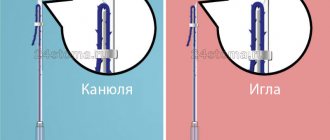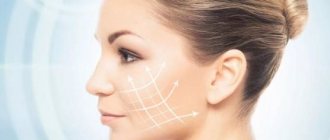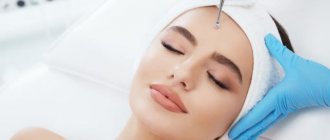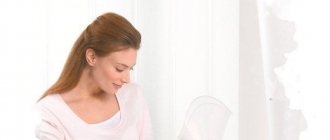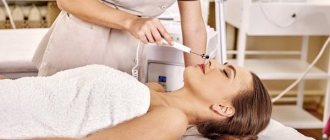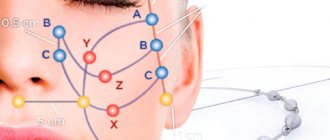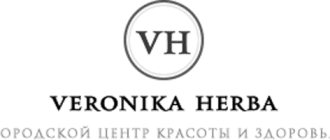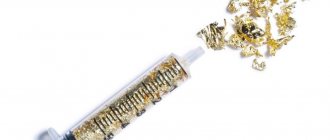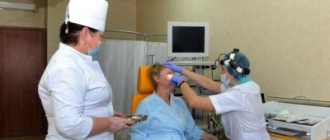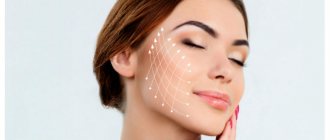general description
Kogi threads (Cog) are needle-shaped mesothreads. Their notches, which ensure reliable fixation during lifting, are located in different directions. They include several components: the body of the thread itself, a cannula, and a conductor made of Japanese steel.
The material completely dissolves after a year or a year and a half, after 3-5 years it is necessary to repeat the administration again.
The procedure is not cheap, but the resulting effect is comparable to the result of plastic surgery. Rehabilitation is quick and does not require additional measures.
Cosmetic products are produced by many companies. The most popular are:
- Omega;
- Beaute' lift V Line;
- EVE COG;
- VERSATILE Uni.
What exactly needs to be injected under the patient’s skin is decided by the doctor after a full diagnosis. It must take into account the skin type, the condition of the person as a whole, and the presence of problem areas.
Action of threads
After puncture into the deep layers of the dermis or muscle tissue, the special composition of the cog threads allows, with gradual resorption, to have a biostimulating effect on the surrounding tissues.
Some cosmetologists claim that the introduced threads are a frame that supports the skin. Other experts believe that they are too thin and, apart from stimulating metabolism and the production of certain compounds, it is impossible to obtain additional functions from them.
Lifting results:
- skin rejuvenation;
- smoothing of superficial and deep wrinkles;
- correction of certain areas, for example, raising the eyebrows, changing the lower part of the face.
Defects can be eliminated not only on the face, but also in the décolleté, buttocks, and abdomen. All details need to be clarified with a cosmetologist.
What are kogi threads?
Cog mesothreads are threads with notches implanted into the dermis. Such threads are installed using small punctures with a needle and passing them under the skin. They are not perceived by the body as a foreign body and are not rejected, but are completely compatible. Such mesothreads dissolve in 1-1.5 months.
Unlike other mesothreads, they consist of a guide needle, a hollow tube (cannula) and a mesothread with notches, which allow for high-quality skin tightening. These notches are located in different directions, which ensures reliable fixation. Laser sharpening of the needle helps to penetrate the dermis quickly and practically without injury.
The threads themselves are made from biodegradable material, which dissolves perfectly in the dermis. After their installation, they apparently tighten the skin due to the notches. Later, during resorption, they begin to secrete components that activate the growth of connective tissue, elastin and collagen. Thus, metabolism occurs at the cellular level, improving the structure, quality and tone of the skin. Blood microcirculation improves and cells receive more nutrients and oxygen.
After complete resorption, Cog threads leave a dense natural framework that continues to maintain the established shape of the face or body for a long time. The end products of the decomposition of mesothreads are water and carbon dioxide, which are completely removed from the body. After the effect wears off, the procedure can be repeated.
Of course, there is one significant disadvantage - it is expensive. The technology of lifting with kogi mesothreads gives results at the level of plastic surgery with a long-lasting effect, but the recovery and process are short-term. They are practical, safe and effective.
The features of Cog mesothreads include the following aspects:
- To process one zone, a large number of threads is not required. 4-5 pieces are enough;
- They are used not only for mild forms of sagging, sagging and displacement of the skin, but also for moderate cases of the formation of jowls and a “creeping” oval of the face. With strong changes, even this method will not help;
- The result of the tightening lasts 3-4 years, unlike linear threads;
- Perfectly combined with the implantation of other mesothreads;
- The repeated procedure involves a smaller number of reinforced mesothreads;
Thanks to multidirectional cuts, the kogi threads perfectly hold the dermis.
Indications and contraindications
A facelift with mesothreads is necessary when other methods of skin rejuvenation are ineffective, and it is too early to perform classical plastic surgery.
Lifting is recommended for:
- formation of deep wrinkles;
- drooping eyebrows, corners of the eyes and mouth;
- appearance of a double chin;
- sagging skin;
- unclear boundaries of the oval face.
Not everyone can have mesothreads injected. List of contraindications:
- individual intolerance to the material from which the threads are made, the risk of developing an allergic reaction;
- pregnancy and lactation;
- growth of malignant neoplasms;
- infectious inflammation, presence of pustules;
- exacerbation of chronic pathologies;
- taking medications that affect blood clotting;
- tendency to form keloid scars;
- uncontrolled arterial hypertension (symptomatic, essential);
- diseases affecting the hematopoietic system;
- primary or secondary decrease in the functional activity of the immune system organs;
- undergone 6 months or less of surgical interventions;
- burns, cuts and other violations of the integrity of the skin in the area where the threads are to be inserted.
Thread lifting for correction of facial contours. My experience before and after. A little about fillers and Botox
The post will be long, not the most pleasant and aesthetically pleasing.
All photos were taken on a phone, the quality is sometimes questionable, I wasn’t going to write a post about it. Almost everyone is cropped - I didn’t have a photo of me without someone next to me, so I immediately apologize for the quality.
Before I start, I wanted to thank everyone who read my first posts on Cosmetist. Thank you for such warm comments and support. I have been with you for more than five years as an invisible reader, I have “known” and respected many for years. Your feedback is very important to me.
Don’t judge, don’t renounce, don’t be afraid. I’ll tell you how I came to injections and threads.
I am 38.5 years old, dry, dehydrated skin. My parents and nature rewarded me with a good appearance, figure, and hair. Yes, like almost all of us, we would like “more there” and “less here,” but that’s what we have. Until the age of 23, the word skincare cosmetics for me meant deodorant (decorative products don’t count, there was always a lot of it). Then, from 25 to 30, one Vichy moisturizing cream and then when I remember. Thoughts about injections in the back of my mind (sometimes there were advertisements on TV) were something like - oh, this is definitely not for me. But they weren’t there at all)
There are photos (screenshots of social network pages of me at 30 years old before all the interventions). The quality is disgusting, but that's what it is. There is photoshop here, the area under the eyes is blurred, but they are not my topic today. If someone finds a more decent photo, I’ll change it (thanks to my brother, I just found a couple of photos, I’ll make changes, I’ll change one photo) The person is 30 years old, without makeup at all and without Photoshop in photo 2 with red hair Photos 1 and 2
But then fate brought me to work in a cosmetology clinic. Treatments, injections, plastic surgery. Invaluable experience. For two years, I observed clients of different ages before and after procedures, after six months or more. It's amazing to see what cosmetologists create!
I too have matured. But not for beauty. The contour of my upper lip is destroyed (eaten away by herpes over many years). All the gloss or lipstick runs out because of these micro-creases under my nose, turning me into the Joker (I love wearing makeup). I was offered to make the contour a little clearer with filler, without increasing the volume and size. Honestly, I was afraid that there would be dumplings) Usually 0.8 - 1 ml of filler is injected during the first procedure (for lip augmentation). This is to understand what we are talking about. I ordered 0.5 ml of Restylane lip. I was injected with 0.3 ml strictly along the contour of the upper lip. The remaining 0.2 ml was used for the symmetry of the lower lip and in the columns of the philtrum (relief around the “tick”) The result is gorgeous, it did not affect the volume and size in any way, but I was able to wear any glosses and lipsticks. The contour turned out clear, beautiful and natural. No one saw the difference, not even those closest to me (or rather, I didn’t tell anyone, but no one noticed)
Then there was Dysport (Botox), then nasolabial folds, biorevitalization around the eyes. The filler lasts on average about a year. Even at this stage, if someone told me that in 7 years I would get threads for myself, I would twirl my finger at my temple.
Life changed dramatically and 6 years ago I left for the USA. I didn’t risk doing anything here - I didn’t see how doctors work (not always doctors, by the way), I didn’t see patients before and after.
Two years later I came to visit and, of course, immediately went to see the cosmetologist. I repeated the nasolabial folds, lip contour and Botox. The last one didn't work out for me, the rest is worth it. I was 34 years old at that time.
Then the first pregnancy, baby, breastfeeding. In the photo I’m 35, I was happy with myself Photo 3
A year and a half later, I’ve lost weight (fortunately, my face too), and I’m still happy with myself. Photo 4
But at 37 it started. I finished GW and hated the mirror. What infuriated me the most were the “jowls” and, I think you can see in the photo, some kind of crease after the smile line. Photos 5 and 6
I’ve been at Cosmeticist for more than 5 years, as I said before. I started trying what the girls wrote about (except for decorative products)) Leorex, carboxytherapy, alginates, hydrogel - everything was useless.
I wrote to my cosmetologist. She replied that she could supply the threads for me upon arrival. I Googled it - there is a lot of information, but nothing is clear. I left this topic (moving, not before) In June of this year I flew to Russia. For 4 years my face did not know the hands of a cosmetologist. Well, you understood where I ended up almost immediately.
Usually everything happens like this: I come, say what I don’t like, she voices how I can try to fix it. I don’t go into details, I just lie down and that’s it - I can work. For some reason I thought about the threads that it would be 2-3 threads from the chin to the ear - that’s all. In reality, everything turned out differently.
Theoretical part
Thread lifting is a non-surgical rejuvenation technique.
The technique is more than 15 years old. It is recommended to use in cases where other cosmetic procedures do not produce results. The procedure is indicated for patients over 30 years of age who have sagging soft tissues, changes in facial contours (also used to lift the chest, knees and buttocks). There are a great many threads. At the age of 30-40, absorbable threads are recommended, after 40 - non-absorbable ones. Of course, there are a lot of contraindications (I will give only a few) - infectious diseases - oncological - pregnancy and breastfeeding - diabetes, etc. Next, everything I will write about relates to the absorbable mesothreads that were given to me.
The essence of the method
Using a thin needle, threads are inserted to different depths in different directions. This allows the creation of a three-dimensional frame to support the face. After a while, the threads dissolve, but for a year or two the skin will remain on the collagen frame that has managed to form around the threads.
Advantages
-this is not an operation -short rehabilitation period -no scars -procedure time 30-40 minutes -price
Rehabilitation
Everything here is individual, as you understand. - swelling of the face increases for the first three days, then subsides - bruises go away after 10-14 days - it is necessary to avoid physiotherapy, massage, swimming pool and active sports for about 1-2 months - it is not advisable to mask bruises with cosmetics - it is advisable to use ointments like heparin or troxevasin - sleep on the back for the first time - sometimes the thread can come out. It must be carefully pulled out and the area treated with an antiseptic - do not visit the dentist (and you won’t be able to, you can’t really open your mouth)
How long does the result last?
They promise about one or two years, but, of course, it also depends on the characteristics of the body (they also promise about Botox) / The threads disintegrate (dissolve) and are removed from the body after 4-6 months. The basis of the thread material is polydiaxone, it is used in surgery for stitching tissue)
The theory is over, now let’s get to the point: how it happened to me
Please keep in mind that I did everything at once: nasolabial folds, lips and threads.
1. The doctor applies emla ointment to the desired area (they covered the entire lower half of my face) and under the film for half an hour (just a culinary recipe). 2. Next, she outlines the “weak points” and marks the thread insertion pattern. 3. Using a cannula (thin hollow needle), the threads themselves are inserted. As it turned out later, 20 threads were inserted into me, 10 on each side of my face in the area from the chin to the ear, almost along the jaw line (I hope this is clear). The threads are small, thin, like a wire, 1.5 - 2 cm long each. 4. The procedure took 30-40 minutes
Impression
- It hurts. No, it hurts
. To understand the pain threshold: I do Botox live, I don’t feel anything. Nasolabial folds - pain relief with ointment; the filler itself is always without lidocaine. Unpleasant, but normal. Lips - pain relief with ointment, filler without lidocaine - it hurts, it always hurts. But here... it feels like you are being sewn. More precisely, I saw myself as a sofa cushion on which buttons are sewn. — The appearance after the procedure and the next two weeks as a victim of domestic violence, I was driving home and caught the sympathetic glances of a taxi driver, a week later another one even promised to “break the hands of the one who did this”)) — it is necessary to restrain facial expressions. This turned out to be a problem. Everyone immediately started making me laugh. - Eating also hurts. My mouth almost didn’t open, this is my second pain, I love to eat, but with any movement of my jaw the threads prick and shoot (feels like a needle under a nail) - the third pain is sleeping on my back. More precisely, “sleeping” is conditional. I took painkillers to help me sleep at all for the first couple of days. On the second day, my face became more swollen. Touch it or don't touch it - it hurts the same. I took the first photos after about 10-14 days, there was no more swelling, but the bruises floated to the neck. I returned to the states three weeks after the procedure - the bruises were still very noticeable. Photos 7 and 8
It’s not just words about restraining facial expressions. It is very important. I laughed a lot on the second day after the procedure, crying and holding my cheeks with my hands. Tears flowed, I howled in pain, but neighed like a horse, sorry. As a result, two threads pushed out a little and began to protrude outward near the mouth. It looked very dark, like internal acne. They need to be carefully screwed inwards with a twisting motion, without pressing too hard. I couldn't screw them in, and they stuck out from the inside under the skin for a couple of months. Photo 9
During the first two months, the threads were barely visible in some places if you stretched the skin (as if they were pieces of thin wire)
Let me summarize
Cons: Painful, ugly, many restrictions.
The bruises lasted a month. For another month I felt “shooting” in my face. The mouth did not open wide (you can’t bite a sausage in the dough - something like this) Pros: Fast, not particularly expensive, I’m more than happy with the result. Of course, I did not become the owner of the oval shape of a twenty-year-old girl, but the hated fold almost disappeared, the jowls disappeared, and my face as a whole was tightened. Three months after the procedure, nothing was felt under the skin, the tubercles disappeared completely, the skin became a little denser. Photo from September, three months after the procedure Photo 10
Now I’ll attach a photo now, 5 months later.
Without cosmetics for the purity of the experiment, so that nothing bleeds the skin Photos 11 and 12
With foundation without powder for the overall picture Photos 13 and 14
I regret that I didn’t put it in my eyebrows, my eyelids began to droop) I’m waiting for your questions, reviews, comments. How much the appearance has changed and in what direction - an outside view. If anyone has had experience pinning the eyebrow fold with filler and then smoothing it out with Botox, I would be very grateful if you share, maybe in a private message.
Special thanks to you, Alfiya, for encouraging me to write this post, perhaps it will help someone make up their mind. I numbered the photos for questions. Sincerely, Svetlana
Increase
Advantages and disadvantages
| pros | Minuses |
|
|
Review of manufacturers
On the cosmetics market you can find various types of cog threads for lifting; let’s look at the most common brands.
Omega 7
Korean threads are considered the most popular in Russia. Manufacturer: OV World. Price - about 700 rubles.
There are several types of threads:
| Omega VL Original (140 mm) | Omega VL Spike | Omega VL |
| The notches are directed in one direction | The notches are in a spiral, their directions are different | Mesothreads are short, notches are multidirectional |
| Minimally invasive skin tightening along natural lifting vectors | Designed for more reliable fixation of the skin and achieving long-lasting effect | A delicate tightening of the nasolabial triangle, drooping eyelids and eyebrows is achieved |
Cosmetologists prefer to combine all three types with each other for the best result.
Beauty' lift V Line 7
Like Omega 7, the threads are made in Korea and the conductors are ground and sharpened in Japan.
Cost - from 700 rubles and above. It is based on polydioxazone, which breaks down within six months and is replaced by connective tissue.
As a result, a dense frame is formed that holds the skin in its proper place.
Buyanov Sergey Yurievich (Expert Doctor):
Connective tissue strands serve as a kind of matrix for strengthening areas of skin tightly adjacent to them. Fusion with the muscle layer occurs, due to which the extensibility is reduced, and therefore the tendency to form folds.
EVE COG 7
The thread is thick, also made of polydioxazone. The material is additionally polished to reduce the likelihood of additional tissue trauma. The kit includes a puncture needle made of durable steel and laser sharpened.
The result is not inferior to Korean analogues, it costs from 450 rubles.
VERSATILE
There are two or more threads in one package, the price starts from 1,700 rubles.
The notches on the threads are arranged in a spiral, the length is 5-6 cm. It fixes tissue well and is mainly used to tighten the nasolabial triangle and smooth out deep wrinkles in the eye and forehead areas.
Time Machine
In terms of properties and cosmetic results, they are not inferior to other brands. Cost - from 600 rubles.
The threads are designed for 4D lifting; they have a large diameter and an increased number of notches located at different angles.
The surface of polydioxazone is treated with polylactic acid, which moisturizes and nourishes the epithelium.
Result of the procedure
Using Cog threads for a facelift allows you to achieve a number of effects:
- reinforcement and strengthening of the skin frame;
- correction of the oval and contours of the face, enhancing their clarity;
- skin tightening and lifting;
- formation of an attractive and expressive cheekbone line;
- smoothing folds and wrinkles;
- eliminating ptosis and sagging skin, improving its turgor and tone;
- skin rejuvenation by stimulating neocollagenogenesis and elastin formation;
- elimination of asymmetry of facial features.
The result of the procedure is visible immediately after its implementation and reaches a maximum after 1.5 months. The effect of face lifting and rejuvenation lasts for up to 1-2 years.
Carrying out the procedure
A facelift with Kogi threads consists of three stages: preparation, the procedure itself and the healing period with subsequent care. Let's take a closer look at each of them.
Preparation
Before lifting, it is very important to find a professional cosmetologist, because the result depends on the skill of the doctor.
Without proper experience, you can insert the threads incorrectly, forget about some nuances, and give incorrect recommendations. The result is the formation of complications or the absence of the expected result.
At the initial consultation, the specialist collects a detailed medical history, clarifies the presence of pathologies, and conducts a general examination.
Perhaps he will refer you to a therapist, recommend tests for laboratory diagnostics, or undergo a course of treatment if indicated.
How it goes
The procedure itself consists of several points:
- cleansing the skin of impurities, sebaceous gland secretions and cosmetics using professional means;
- applying markings to make it easier to understand where to insert the threads;
- disinfection of areas with antiseptics 3-4 times;
- the use of an anesthetic in the form of a cream or injection, the choice is made by a cosmetologist taking into account the sensitivity of the patient’s tissues;
- unsealing the threads immediately before insertion;
- piercing the skin with a puncture needle 3-5 mm, inserting a thread through a guide;
- after installation, tension occurs and a frame is formed;
- applying an elastic bandage, which can be removed only after a week.
No more than 10-11 threads are used in one procedure, although up to 60 threads are required for complete cheek correction. This is associated with the risk of side effects.
Indications for reinforcing threads –
The most common indication for the use of reinforcing threads is the correction of age-related changes in the cheek-zygomatic area. In addition, reinforcing threads are the best option for correction in the areas of the shoulders, chest, hips, abdomen, buttocks and hands, and they are many times more effective than conventional mesothreads, the effect of which you most likely will not see at all. In the facial area, there are the following indications for their use:
- reducing the depth of nasolabial and labiomental folds,
- correction of mild ptosis,
- prevention of age-related changes in the middle and lower third of the face,
- optionally – increasing the volume of the cheekbones and cheeks.
There are also schemes for installing reinforcing threads for forehead lifting and eyebrow lifting. But we generally do not recommend that you do either reinforcing or lifting threads for these indications, because... the result is quite controversial, and the trauma is quite large. A much better and longer-lasting result will be achieved by endoscopic forehead lifting/surgical brow lifting.
Important: an important point - the use of reinforcing threads on the neck is completely pointless, and although specialized literature describes neck reinforcement techniques, the result of such techniques tends to zero. As a rule, reinforcing threads on the neck are recommended by those cosmetologists who simply do not know the techniques for installing lifting threads. In addition, reinforcing threads are not suitable for patients with “heavy faces” and significant tissue sagging. Only a slight degree of soft tissue ptosis is acceptable. Also, this type of thread will not be effective for correcting the oval of the face, or if you are planning to remove jowls or get rid of a double chin.
Pros and cons of reinforcing threads –
As you already understand, lifting threads have the most powerful lifting effect, but they have several disadvantages, for example, after the skin is stretched, folds temporarily form in the parotid area. Such folds decrease in about 2-3 months, but if the patient wishes, they can be removed in one procedure through minor surgical correction. In turn, the use of reinforcing threads does not lead to the appearance of such folds. Plus, after installing reinforcing threads, the rehabilitation period will be shorter - about 1.5-2 weeks (for lifting threads - 2-2.5 weeks).
An important point is that the use of lifting threads is, in principle, only possible in patients with thick skin (with moderate or low elasticity). In patients with loose and/or elastosis-prone skin, the effect of lifting threads will be extremely short-lived, and in order to install lifting threads in such patients, you will first have to undergo a course of mesothreads to increase skin density. In turn, for the installation of reinforcing threads, the density and elasticity of the skin do not matter.
The disadvantages of reinforcing threads include the fact that they can only be used with a slight degree of soft tissue ptosis. This is due to the fact that the design of the threads and the technique of their installation do not imply their fixation to fixed anatomical structures (ligaments, aponeuroses). The introduction of reinforcing threads in patients with “heavy faces” will further increase the mass of soft tissues and intensify the phenomena of gravitational ptosis. Therefore, it is very important to strictly follow the indications for their installation.
But if a patient with a deformational (edematous) type of aging is clearly determined to use reinforcing threads, then in some cases this still becomes possible. For example, after a preliminary course of mesotherapy of the face and neck with vascular drugs and lipolytics. These groups of drugs will activate blood supply and lymphatic drainage, remove swelling and pastiness, activate lipolysis and, thus, reduce the volume of fat deposits.
Healing period
After installation of Kogi threads, swelling, discomfort, pain, and small hematomas may develop. All of the above changes disappear within 2-7 days without any intervention.
To achieve the greatest effect, you must follow the recommendations of a care specialist and remember some restrictions.
After removing the bandage, all skin care procedures are performed with napkins. So you need to apply Panthenol in the form of a cream or ointment and antiseptic to treat punctures.
Recommendations also include the following points:
- sleep on your back with a raised pillow to avoid displacement of the threads and deformation of the face;
- temporarily exclude visiting beaches, solariums, swimming pools, saunas;
- do not apply new, untested cosmetics, so as not to cause an allergic reaction;
- watch your facial expressions, react more restrained and calmly;
- Limit sports activities and reduce physical activity.
The threads completely dissolve in 12-18 months, the result lasts 3-5 years. When it decreases, it is allowed to carry out additional correction using a minimum number of mesothreads.
Buyanov Sergey Yurievich (Expert Doctor):
After introducing mesothreads, it is necessary to minimize the contraction of facial muscles. You need to be psychologically attuned to this, otherwise you can lose a positive result just because of one smile.
How long does the procedure and recovery last?
Lifting with threads is performed within an hour, sometimes even faster - depending on the volume of correction. Since there are no surgical incisions and local anesthesia is used, the recovery period lasts 1-2 weeks, bruising and swelling are rare. Immediately after the procedure, patients can engage in normal activities, only vigorous physical activity is limited.
To maintain the effect longer, you must follow certain rules. If the threads were installed in the face, you should not sleep on your stomach, “face into the pillow.” For the first 7 days, you should not wash your face with hot water or engage in active sports. Baths, saunas and solariums are also prohibited for two weeks. In addition, you need to try to ensure that there are no shifts of the threads from the notches, so movements in the orbital zone are limited - for example, you should not open your mouth too much.
Thread lifting has contraindications. You need to consult a specialist about this.
Doctors say that the result after the procedure can be seen within a week. But, of course, threads will not ensure youth forever. The effect lasts 2-3 years depending on the characteristics of the body. So the installation of threads will have to be repeated regularly.
Precautionary measures
Experts advise not to perform chemical peels and facial massage for a month.
Heat increases the breakdown of the material, so you should not be in direct sunlight, take a steam bath, sauna, or sunbathe in a solarium.
All cosmetics containing hyaluronic acid are prohibited. This connection significantly increases the rate of thread resorption.
Drinking alcoholic beverages is unacceptable; alcohol has a bad effect on collagen production and removes psychological restrictions on excessive emotions and mobility.
Side effects
Compared to other threads for face lifting, Kogi have some advantages, the main ones being the minimal risk of complications and tight fixation.
However, the occurrence of side effects in the form of:
- pain syndrome;
- hematoma;
- tissue swelling;
- moving the thread, breaking it;
- development of seals;
- facial deformities.
You need to tell the doctor about any changes that the doctor did not warn about and go for an examination. Otherwise, inflammation and secondary infection develop.
Types of threads
It is necessary to find out exactly what threads are available for facelifts, since there are a lot of varieties. For the production of the starting material, both absorbable material and completely stable material are used, the results of which last longer.
Types of absorbable threads:
- 3D mesothreads;
- Aptos Light Lift (notched threads);
- Anchor lift;
- Happy Lift.
Types of threads for face lifting that do not dissolve or dissolve slowly:
- gold, platinum;
- Teflon;
- polypropylene (aptos Surgical);
- Tissulift.
Combined:
Silhouette Lift.
Mesothreads
Mesothreads are the thinnest cosmetic threads that dissolve in the body over time. Such threads are introduced using a special blunt-ended needle, which does not pierce the skin, but pushes the cells apart. This technique is recognized as the least traumatic for the body - but requires high professionalism from the doctor. One wrong move and serious consequences can arise.
After six months, the threads dissolve, and a supporting collagen frame remains in place, which helps maintain the effect for up to two years.
They are used exclusively at the first signs of aging at the age of 30-40 years, not suitable for people with severe age-related changes.
The procedure is also carried out in cosmetology clinics - it is not necessary to contact plastic surgeons.
Platinum and gold
Platinum and gold threads are classified as non-absorbable. Once a good lift, it is now considered outdated. Previously, noble metals were used for lifting due to their low chemical activity - and the most inert were gold and platinum.
Silhouette Lift Soft
Surgical threads Silhouette Lift Soft are not smooth - they have cones and knots that help fix the fabric in certain places. The base of the thread is polypropylene; the thread contains nodules (up to 11) of lactic acid and glycolide, which subsequently dissolve. In this place, only new connective tissue remains, which provides the lifting effect.
It is also used for medical reasons, when age-related changes become especially serious - but still before the age of 50.
The disadvantages include the possibility of the appearance of tubercles in the places where the nodules are attached, and swelling of the face during the rehabilitation period. During this same period, active facial expressions and laughter are prohibited.
Aptos
Non-absorbable Apros threads are distinguished by characteristic barbs, thanks to which they are fixed in the tissue. The thread enters the flesh shallowly - about 4 mm - through a tiny puncture. Apros has a wide selection of threads depending on the area that needs to be corrected and the composition:
- polymilk (effect up to 2 years);
- polypropylene (effect up to 4 years).
The rehabilitation period is 2 weeks; during the first month, handle your face with extreme caution. You can trust this procedure only to trusted specialists.
Photos before and after
Cost of services in salons
The price depends on the salon or medical center offering a similar service, the material the doctor uses and the region where the patient lives.
| City | Cost for 1 thread in rubles |
| Moscow | From 4000 |
| Ekaterinburg | 2500-5000 |
| Chelyabinsk | 4500-7500 |
| Tomsk | 4000-7000 |
| Kazan | 5000-7500 |
| Vladivostok | From 5000 |
| Krasnodar | 6000-9000 |
Opinion of cosmetologists
Professionals do not give general positive or negative comments. Some support this method of rejuvenation, others say it is ineffective.
On forums you can find answers from cosmetologists; here a specialist talks about the method of pain relief during the procedure:
And in this case, the doctor advises at what point and with what threads to perform a facelift.
How is the procedure done?
Preparation for the manipulation begins several days before the actual procedure. An initial consultation with a specialist will be based on identifying indications and contraindications. Perhaps the patient will be advised to undergo examination by a therapist and some other specialists, have an electrocardiogram done and undergo several general tests. After all the details are clarified, a date for the procedure is set.
- First of all, a doctor or cosmetologist (necessarily licensed to carry out such manipulations) examines the “front of work”.
- Next, a drawing diagram is applied for the correct and most effective introduction of threads.
- The skin is cleaned with special products, after which an antiseptic solution is applied, which eliminates the risk of infection getting into the punctures and under the skin.
- The area is treated with an antiseptic cream, which begins to act in 15-20 minutes. If necessary (high threshold of pain sensitivity, work in certain areas), general anesthesia is given, but this method of pain relief for thread lifting is used very rarely.
- Then the threads are introduced using a highly durable and flexible needle. A facelift with kogi threads takes from 30 to 60 minutes, depending on the amount of material required.
After this, the patient spends literally an hour in the clinic and can go home. Before leaving, he is told about all the precautions and rules of conduct during the rehabilitation period.
We recommend reading: reviews of facelift threads.
You can watch how the procedure is performed using Kogi threads in the video:
